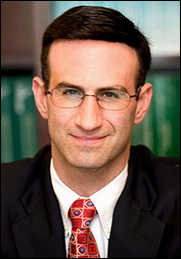An HIT Moment with … Steve Schelhammer
An HIT Moment with ... is a quick interview with someone we find interesting. Steve Schelhammer is CEO of Phytel.
How is Proactive Patient Outreach different than the recall systems included in most practice management software?
Proactive Patient Outreach is a Web-based service that includes an electronic patient registry, a protocol engine based on nationally recognized guidelines for preventive and chronic disease care, and an automated messaging system that contacts patients who need services. Phytel provides a variety of management and physician feedback reports, and it helps practices qualify for pay-for-performance, PQRI, and medical home incentives. We also have a medical economics team that works with customers to help them analyze their patient population and improve the quality of care.
In contrast, practice management software merely reminds office staff when to contact particular patients for follow up, and those reminders are entered in the system only when physicians order it. What we’ve done is to systematize physician-driven population health management and to make recalls automatic instead of hit-or-miss. In that sense, we’re offering more than technology; we’re providing a health improvement service built around compliance, outcomes, and extending the influence of the physician beyond the visits that patient initiate themselves.
Last year CMS named Phytel a qualified patient registry for PQRI reporting. What does that mean for your average physician client?
What it means is that we can now submit PQRI data automatically from our registry, without physicians having to do anything or worry about which patients they should be collecting data on. It also saves staff a lot of time entering CPT II codes in their billing systems.
The administrative burden on practices was the main reason why only 16 percent of physicians reported PQRI data in 2007. They just didn’t feel it was worth doing the extra work to get the incentive. But in 2008, Medicare raised the incentive from 1.5 percent to 2 percent of charges, and it also provided an alternative method of submitting the data. If you use a CMS-approved electronic registry like Phytel’s, you only have to send in data on 30 consecutive patients with a specified condition—and only two of those need to be Medicare patients.
We extract most of the necessary data from practice management systems and electronic health records, including lab data if a practice has an EHR or a lab interface. Where required information is not in the available fields, our program prompts users to enter the missing data, such as whether a diabetic patient has had an eye exam.
What impact does the ARRA have on Phytel, both good and bad?
ARRA will be highly favorable to our company’s strategic direction in the field of population health management. The legislation requires “meaningful use” of EHRs to qualify for financial incentives, and it’s clear that part of that will be the ability to capture and report quality data. Today, few EHRs—including those with the latest CCHIT certification—have robust registry functions. So physicians will have to combine EHRs with outside services like Phytel’s in order to report performance data, unless they want to devote a huge amount of staff time to data entry or pay for custom reports to show meaningful use.
Also, EHRs do not include automated outreach and patient self-management capabilities. Even if they were combined with a commercial technology solution, they would still lack the ability to tailor the messaging to clinical protocols. It’s instructive that the majority of our customers have EHRs, yet had difficulty in reaching out to noncompliant patients before they used our service.
Physicians don’t need an EHR if they want to use Phytel to bring in patients for needed services. But to the extent that ARRA’s incentives encourage more physicians to adopt EHRs, I believe that it will increase the impact of Phytel. By enabling us to populate registries with more granular clinical data, the spread of EHRs will help physicians pinpoint the patients who really need help and get them to make appointments before their conditions worsen. And that will contribute to better outcomes for their patient population.
What trends are you seeing in regard to provider reimbursement and evidence-based medicine and where does Phytel fit in?
Physicians will increasingly be paid on the basis of their quality and their patient outcomes rather than the volume of services that they provide. While fee for service is still the predominant method of reimbursement, pay for performance and the medical home trend are already shifting a significant chunk of physician income to quality-based incentives. For example, California health plans paid out more than $200 million in P4P incentives to medical groups and IPAs from 2003 to 2007. And Blue Cross and Blue Shield of Michigan recently launched a program that will pay physicians who create medical homes a 10 percent bonus, starting in July.
A key requirement of both P4P and medical homes is that physicians must follow evidence-based-medicine guidelines. Most physicians think they’re doing that, but a broad body of research, including the Dartmouth Medical School studies on variations in care, shows that it just isn’t so. The study that really woke up everybody up a few years ago was the RAND report that revealed patients were receiving only 55 percent of recommended care, on average.
What the RAND study failed to point out is that many patients don’t receive the care they should because they don’t comply with their physicians’ treatment plans. This is a problem that Phytel can help physicians alleviate. By strengthening the physician-patient relationship, by helping doctors optimize the value of each patient visit, and by extending the communication between physicians and patients beyond the walls of the office, we give doctors vital tools for improving patient health.
Phytel is very interested in participating in the emerging patient centered medical home health improvement initiatives. The AAFP’s TransforMED project endorsed Phytel, and I’m on the board of the Patient Centered Primary Care Collaborative, which is promoting the medical home concept at a national level. The PCPCC has more than 400 members, including major employers, consumer groups, patient quality organizations, health plans, labor unions, hospitals, and physicians.
Many health plans are doing medical home pilots, and some are rewarding physicians who have been recognized by the NCQA as medical homes. For example, Dr. Joseph Mambu, a Phytel customer who qualified for the top level of NCQA recognition, expects to receive a medical home incentive of more than $40,000 through a statewide initiative in Pennsylvania. Judging by the NCQA criteria, we believe that many other Phytel clients could use our service as a building block to qualify as medical homes.
What are some of the more unusual ways your clients are using Proactive Patient Outreach?
Many of our clients are focusing on particular chronic conditions, such as diabetes or congestive heart failure, that generate a lot of morbidity, complications, and costs. And some practices are customizing our protocols in very specific ways. For example, the Holzer Clinic, a multispecialty group in Ohio, has scheduled bi-annual callbacks for older patients with certain conditions, rather than using the four-month intervals recommended by some national guidelines. Holzer’s physicians are doing that because they recognize that for a lot of elderly patients, noncompliance is related to their inability to come in frequently for appointments.
A Midwestern healthcare system gave us very specific parameters to increase the number of patients who were getting recommended flu shots. The practice targeted higher risk populations, including children, adults over 50, and individuals with chronic conditions that would make them vulnerable to influenza complications. Phytel was instructed to contact these patients between Oct. 2, 2008 and Jan. 22 of this year. As a result of this intervention, the system saw a 15 percent increase in the number of patients getting flu shots compared with the previous year. The power of this approach was also shown by the fact that 15 percent of the older adults who were contacted received flu shots, versus only 4 percent of those who did not respond to our phone calls.
The customizability of our protocols is important to physicians. They don’t usually change very much in the national guidelines, but they like the ability to tailor the protocols to their own practice styles and the community standard of care. Pay-for- performance measures also vary somewhat from one insurer to another, so the ability to customize protocols to patients in different plans can help physicians obtain the maximum P4P rewards they’re entitled to.
The most important thing we do, however, is to enable physicians to do population health management at a very high level without diverting scarce resources from their other objectives. Health care is badly in need of technology that can automate the repetitive, time-consuming aspects of preventive care and longitudinal disease management, and that is what we provide.







The article about Pediatric Associates in CA has a nugget with a potentially outsized impact: the implication that VFC vaccines…